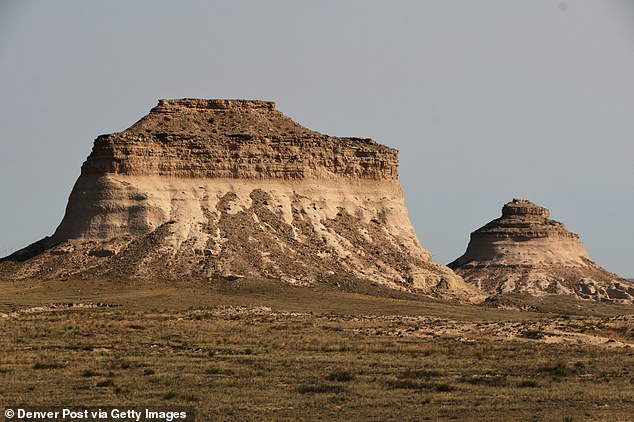The breathtaking Wild West landscape with a perfectly preserved ghost town that hardly anyone visits

Famous for its high-flying ski paradises and Rocky Mountain National Park, Colorado has a lot to offer tourists.
But those looking for a hidden gem untouched by the crowds need look no further than the Pawnee Buttes, a pair of 300-foot rock formations in the grassy plains of northern Colorado.
The striking buttes are named after the Pawnee, one of four Indian tribes that hunted bison in the area already 12,000 years ago.
American homesteaders would settle here later in the 19th century, leaving behind the ghost town of Keota.
The town – now little more than a handful of decaying structures and a water tower – is a 22-minute drive from the buttes, making it a worthy stop while visiting the Pawnee National Grassland.

The Pawnee Buttes on Thursday, October 10, 2024. The 300-foot rock formations are located in the northeastern corner of Weld County, Colorado, about 13 miles south of the Wyoming border

The ghost town of Keota, once home to American homesteaders, is about a 20-minute drive from the buttes
In the historical novel “Centennial,” which catalogs the beauties of northern Colorado, bestselling author James Michener said it probably took 200,000 years for the buttes to form.
“They were extraordinary, these two guardians of the plains,” he wrote in the 1974 book. “Visible for miles in every direction, they guarded a bleak and silent empire.”
Michener also provided breathtaking descriptions of the formations – which he fictionally named “Rattlesnake Buttes.”
“From the buttes, a man could look east at dawn and see hundreds of miles of unbroken horizons, stark meadow after meadow beyond human imagination,” he wrote. ‘The colors were beautiful, but the uninitiated could look at them and not see them, for they were soft grays and delicate browns and azure purples.’
Today, the majesty of the buttes is still as clear.

Someone stares at the Pawnee Buttes, which are made of crumbling sandstone

One of the buttes can be seen just before sunset

A map shows where the Pawnee Butts are located in Colorado, about a 115-mile drive from Denver
Visitors can enjoy scenic views from the Pawnee Buttes trailhead. Or they can hike about two miles to a nearby slope for an even better view.
The Pawnee National Grassland, managed by the Arapaho and Roosevelt National Forests, is best visited during the fall and spring to avoid crippling heat. Temperatures during the summer can reach 100 degrees Fahrenheit.
Just 100 years ago, the prairie was no longer so grassy thanks to a series of catastrophic dust storms that wreaked havoc on the agricultural potential of much of the Midwest.
This era became known as the Dust Bowl and coincided with the Great Depression of the 1930s. This meant that the fleeing farmers fared little better in the cities of California and other Western states.
Dust Bowl storms were exactly why Keota is now a ghost town.

Pictured: A Keota home in stunningly good condition, complete with a remnant of a fire hydrant

The striking buttes are named after the Pawnee, one of four Native American tribes that hunted bison in the area as early as 12,000 years ago
It was once a thriving place for homesteaders, settlers who were entitled to 160 acres of government land under the Homestead Act of 1862.
One of the conditions necessary to get the land: building a house and cultivating it.
It is said that the law, which was passed when Abraham Lincoln was president, pushed Americans further west.
Although Keota never reached a population of more than 150 people, it did a crucial city for the 1,250 farms in the area.
It was also on a railroad that ran between Sterling, Colorado, and Cheyenne, the capital of Wyoming, allowing farmers to travel outside the area.
There were many businesses in Keota, according to Vernon Koehler, who worked on the grasslands for 15 years as a minerals and soils program manager.

The sun rises on the Pawnee Buttes
“There were car dealers, bookstores, grocers, butchers and bakers,” he said The Denver Post.
‘People lived all over the prairie. There would have been a house about a mile away in each direction,” Koehler continued. “You had thousands of people trying to do it on their farms.
“Trains would have run daily, or almost daily, between Sterling and Cheyenne. Along that route they were small towns scattered about every 10 to 15 miles.”
One of these would have been Sligo, another abandoned community 10 miles north of Keota.
All that remains of the town is a cemetery, where gravestones still stand.
“If you wander around and look at the dates, you realize that the very first people buried here were children who died during the Spanish flu pandemic” from 1918 to 1920, Koehler told the Post. “They were about two years old.”

Sligo Cemetery in northern Colorado. Many of the graves were for children who probably died from the Spanish flu in the early 20th century

Gravestones sparsely populate the cemetery
The U.S. Forest Service Instructs hikers not to disturb hawks, eagles and falcons from March 1 to June 30, the time they nest in the cliffs.
Those with a taste for thrills are advised not to climb the Pawnee Buttes as they are made of crumbling sandstone.
The grassland is also perfect for birdwatchers, who can benefit from a self-guided birdwatching tour.
“The best time to visit is in May and June, when the migrants (birds) are passing through and the local breeders arrive at their breeding grounds,” said the Cornell Lab for Ornithology.
‘In late spring the birds are busy, at the height of the breeding season, and the grasslands are in full bloom. With as many as 301 species of birds using these windswept plains, the Pawnee is a birdwatcher’s paradise.”
But above all, the grasslands are a peaceful place to reflect on history, while catching a glimpse of the environment in which previous generations built their lives.
“Ideally, we want people to come here and have the same feeling of walking into a church in Paris that was built in 1100,” Koehler said. ‘There are people here who have been doing things for just as long. They just didn’t leave a physical monument like that.”




